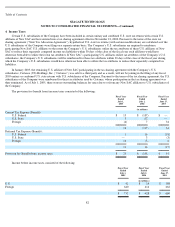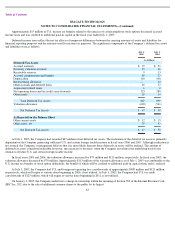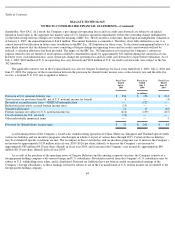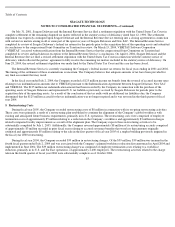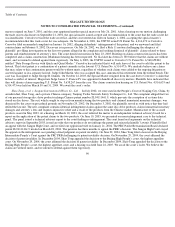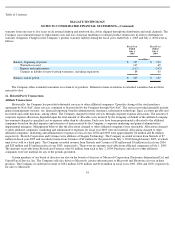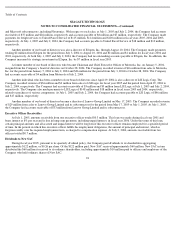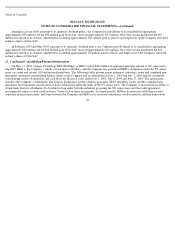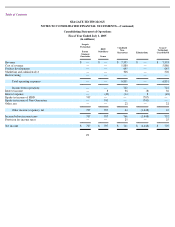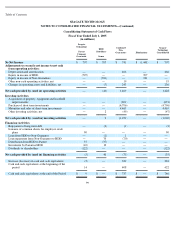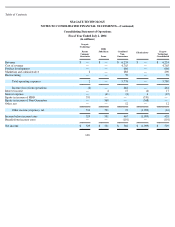Seagate 2004 Annual Report Download - page 94
Download and view the complete annual report
Please find page 94 of the 2004 Seagate annual report below. You can navigate through the pages in the report by either clicking on the pages listed below, or by using the keyword search tool below to find specific information within the annual report.
Table of Contents
SEAGATE TECHNOLOGY
NOTES TO CONSOLIDATED FINANCIAL STATEMENTS—(Continued)
master resigned on June 5, 2001, and the court appointed another special master on July 26, 2001. After a hearing on our motion challenging
the trade secrets disclosure on September 21, 2001, the special master issued a report and recommendation to the court that the trade secret list
was insufficient. Convolve revised the trade secret list, and the court entered an order on January 1, 2002, accepting the special master’s
recommendation that this trade secret list was adequate. On November 6, 2001, the USPTO issued US Patent No. 6,314,473 to Convolve.
Convolve filed an amended complaint on January 16, 2002, alleging defendants’ infringement of this patent, and we answered and filed
counterclaims on February 8, 2002. Discovery is in process. On July 26, 2002, we filed a Rule 11 motion challenging the adequacy of
plaintiffs’ pre-filing investigation on the first two patents alleged in the complaint and seeking dismissal of plaintiffs’ claims related to these
patents and reimbursement of attorney’s fees. The court denied our motion on May 23, 2003. Briefing on claims construction issues has been
completed and a claims construction (Markman) hearing has been requested. No trial date has been set. We believe that the claims are without
merit, and we intend to defend against them vigorously. On May 6, 2003, the USPTO issued to Convolve U.S. Patent No. 6,560,658 B2,
entitled “Data Storage Device with Quick and Quiet Modes.”
Convolve has indicated that it will seek leave of the court to add this patent to the
lawsuit. This latest patent is a continuation of a patent currently in the lawsuit (U.S. Patent No. 6,314,473). We similarly believe any claims
that may relate to this continuation patent would be without merit, regardless of whether such claims were added to the ongoing litigation or
asserted against us in a separate lawsuit. Judge John Martin, who was assigned this case, announced his retirement from the federal bench. The
case was reassigned to Judge George B. Daniels. On October 14, 2003, the Special Master resigned from the case due to Convolve’s claim that
he had a conflict of interest. Magistrate Judge James C. Francis IV was appointed to handle all discovery matters. Plaintiffs have indicated that
they will dismiss claims regarding U.S. Patent No. 5,638,267 from the case. The claims construction hearing on U.S. Patent Nos. 4,916,635 and
6,314,473 was held on March 30 and 31, 2004. We await the court’s order.
Shao Tong, et al. v. Seagate International (Wuxi) Co., Ltd . In July 2002, we were sued in the People’
s Court of Nanjing City, China, by
an individual, Shao Tong, and a private Chinese company, Nanjing Yisike Network Safety Technique Co., Ltd. The complaint alleged that two
of our personal storage disc drive products infringe Chinese patent number ZL94111461.9, which prevents the corruption of systems data
stored on disc drives. The suit, which sought to stop us from manufacturing the two products and claimed immaterial monetary damages, was
dismissed by the court on procedural grounds on November 29, 2002. On December 3, 2002, the plaintiffs served us with notice that they had
refiled the lawsuit. The new complaint contains identical infringement claims against the same disc drive products, claims immaterial monetary
damages and attorney’s fees and requests injunctive relief and a recall of the products from the Chinese market. Manufacture of the accused
products ceased in May 2003. At a hearing on March 10, 2003, the court referred the matter to an independent technical advisory board for a
report on the application of the patent claims to the two products. On June 10, 2003, we presented our non-infringement case to the technical
panel. The panel issued a technical advisory report to the court finding no infringement. The court heard oral arguments on the technical
advisory report in September 2003, issued an order that our products do not infringe the patent and rejected plaintiffs’ lawsuit. Plaintiffs filed
an appeal with the Jiangsu High Court, and we filed our opposition brief on January 21, 2004. The PRC Patent Reexamination Board declared
patent ZL94111461.9 invalid on March 28, 2004. The patentee has three months to appeal the PRB’s decision. The Jiangsu High Court stayed
the appeal on the infringement case pending a final judgment on patent invalidity. On June 22, 2004, Shao Tong filed a lawsuit in the Beijing
Intermediate People’s Court against the PRC PRB challenging its patent invalidity decision. On November 29, 2004, the court affirmed the
decision of patent invalidity. In December 2004, Shao Tong appealed the decision to the Beijing High People’s court, the highest appellate
court. On November 29, 2004, the court affirmed the decision of patent invalidity. In December 2004, Shao Tong appealed the decision to the
Beijing High People’s court, the highest appellate court, and a hearing was held June 22, 2005. We await the court’s order. We believe the
claims are without merit, and we intend to defend against them vigorously.
90




